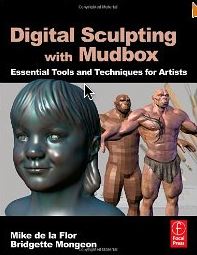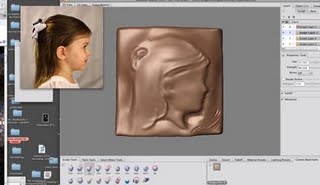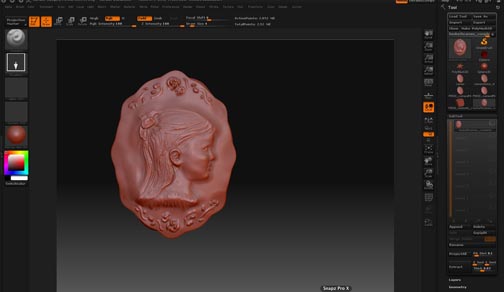Mudbox
3DCAMP Houston Returns In 2012 With The Collaboration Of The University of Houston to Build STEAM
Press Release (Houston, TX—June 24, 2012) 3DCAMP Houston, a local organization supporting education in all things 3D, is proud to announce its return scheduled for Saturday, September 29. The University of Houston College of Natural Sciences and Mathematics and the School of Art will host 3DCAMP Houston 2012, featuring a number of expert speakers who will discuss 3D technologies and how they are impacting new and existing disciplines. This year the camp will also feature an art exhibition to showcase the impact of technology on art.
3D technology, once reserved for the likes of sophisticated science fiction films, has advanced to now include a myriad of artistic and scientific disciplines. This year’s camp will showcase these advancements with presentations exploring innovative technologies. From holographic paintings that tantalize the viewer to 3D printers that produce completely formed sculptures, there is something amazing for everyone to experience.
The goal of 3DCAMP Houston 2012 is to encourage and educate individuals about the use of 3D in various disciplines; therefore 3DCAMP 2012 is returning with STEAM, an educational initiative that supports 3DCAMP Houston educational goal of incorporating and encouraging the blending and education of Science, Technology, Engineering, Art and Math (STEAM).
“The College of Natural Sciences and Mathematics at the University of Houston is pleased to help further the community’s appreciation and knowledge of the many aspects of 3D applications in our modern world. The rapid evolution in visualization technology is playing a critical role in advancing many important areas, from medical and surgical techniques to new methods of energy realization and information transmission,” said Mark A. Smith, dean of the college. “With the university playing a critical role nationwide in these developments, it is satisfying as well as natural to help bring this understanding to our community through 3DCAMP 2012.”
Rex Koontz, director of the university’s School of Art added, “Technology, art and design are converging into a significant force on our cultural and economic landscape. The School of Art welcomes the opportunity to work with the cast of 3DCAMP to further the goal of creating synergies between art and technology.”
3DCAMP Houston is an all-day event and is open to the public. It features lectures and presentations from professionals in the arts, architecture, engineering, science and much more. Online registration will open in July at www.3dcamphouston.com
Vendors will be on hand to demonstrate the possibilities and uses of some of the most interesting and mind-blowing 3D technology. “The Third Dimension,” an art exhibition comprised of 3D art, will be open to the public on Friday, September 28.
For more information concerning 3DCAMP Houston 2012, the art exhibition, and volunteer opportunities please visit www.3dcamphouston.com.
Media Contact:
Bridgette Mongeon
Please feel free to repost this press release, with photo credits.
Is It Easy For You To Identify And Judge 3-Dimensional Shapes, Distances And Proportions On a Computer Screen? An Interview Cont.
9. Is it easy for you to identify and judge 3-dimensional shapes,
distances and proportions on a computer screen?
1. The hardest part, and we mention this in the book is the size of the sculpture. If I am working on a maquette in the studio, I know if I enlarge that maquette 500% I will not have as much detail as I need. So what is the actual size of a virtual piece of art? What happens with the translation from digital work a the size I have created, to the physical size I need output?
2. I would love to see calipers in the digital programs. Something that resembled more traditional calipers in a digital environment.
3. I also was very confused when I first worked in mudbox with perspective view and orthographic view.
4. There is also a cliche with Macs that if you hit the some keys in a certain order your sculpture flips. This is not just a problem with Mudbox or Zbrush but many graphics programs. This freaked me out, and I wish someone could solve this.
5. It is easier for me to judge 3d space now than in the beginning. Though when symmetry begins to act funky, and I know It is some sort of driver error, I get a bit frustrated. I love being able to spin around a sculpture.
6. I do wish that I had more access to my photographs. The one solution I have found for this is Macs Photstickies.
By the way, question number 8 was
8. Which medium is more comofortable for you to use?
( see other posts)
This is an interview of 10 questions by Mathias Herbster of FH Vorarlberg University in Austria directed to Sculptor Bridgette Mongeon about the comparison of digital and traditional sculpture.
______________________________________________________________

Sculptor, Writer and Speaker
Bridgette Mongeon is a sculptor, writer, illustrator and educator as well as a public speaker.
Her blog can be found at https://creativesculpture.com.
She is also the owner and creator of the God’s Word Collectible Sculpture series
Follow the artists on twitter twitter.com/Sculptorwriter twitter.com/creategodsword
Facebook http://www.facebook.com/bridgette.mongeon
Listen to The Creative Christian Podcast or the Inspiration/Generation Podcast Click on Podcast Host Bios for a list of all podcasts.
Listen to the Art and Technology Podcast
Which Medium Do You Think Is More Flexible, Digital or Analog Clay? An Austrian Student Interview Cont.
2. Which medium do you think is more flexible, digital or analog clay?
I have described a bit of this in a previous post, however, in defense of digital sculpting, the tools that are available intrigues me. For example, sculpting symmetrically, though no person is symmetrical, I can change that at the end. But in digital I don’t have to sculpt two eyes, or two ears, etc. When I can shorten the amount of time of getting the shape and instead focus on the detail the technical process allows me more time for creativity.
By far the most hindering part of the digital process is the output. There are still a few factors that interfere with my process in this area. One is cost, and the other is the medium, also the build envelope or size. I’m finishing a bust in traditional clay right now, but I would much rather have created it digitally. However, my resources for out put would have been milling in foam, a good armature for larger pieces, but I would have still had to do the details again, and I do not like the stiff look that a piece of foam covered in clay has.
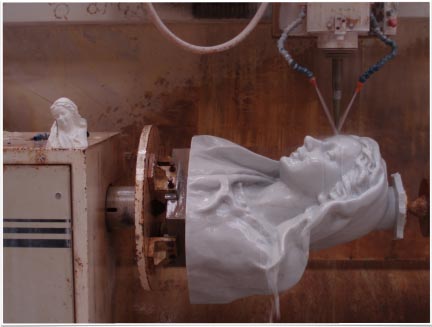
I could mill it out in stone; I must say I anxious to have a project where I can explore this more. All my life I have sculpted in clay, concrete, bronze or pourable mediums. Now with digital milling in stone I can extend my tool set to “stone carver”. With the Digital Stone project, I can create artwork in this medium, as well. This excites me to no end. When I think of the possibilities I also consider the many projects I have given up over the years not having this skill set.
I also love the idea of doing more architectural sculpting work using the digital tools. Creating a finial and being to enlarge it 20% or anything in steps of enlargement is huge. There is no price that can be put on that.
However, digital printing in any other medium is not a viable option, either because of the build envelope or the cost.
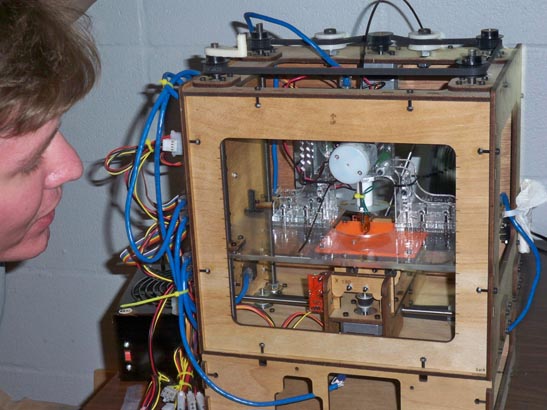
Im intrigued with the research at Solheim Additive Manufacturing Laboratory in the Mechanical Engineering Department on the University of Washington campus. If only I could create in the computer and then digitally print out my form in clay in my own studio, like they are doing at this lab. I think this would be a viable resource for me. I know that the open source “free” 3d printers like Rep Rap or maker bot have some attachments to digitally print in clay, and I’m waiting to see how these evolve.
I think another resources is materialize by .mGX for going directly to bronze, though very expensive. I have visions of using them on an intricate piece similar to Alfred Gilbert’s Virgin Mary or St. Michael. Pieces that would be a nightmare to recreate in a triditional bronze process but could easily be done with .MGX.
The very near future will drastically change the way I work. As many of the patents have ended on 3D printing, I believe you will begin to see a change in the cost factor and availability of home 3D printers. I still may be limited by the build size, unless, of course, I can figure out how to change a machine to accommodate my needs. I’m not sure I am that mechanically savvy.
As I write this, I find an aching. To go from screen to finished project without touching it leaves a hole inside of me. I am afraid I will not be able to “feel” the emotion of the piece unless I touch it. Oh, this is a strange thought.
Though looking at the quick sketches in my Mudbox video I can feel the emotion without touch. Will it feel the same digitally printed?
Remember, I am still a traditional artist. I get paid for a tangible piece of art. I need to get the sculptures out of the computer. I must base my choices on that final output.
This is an interview of 10 questions by Mathias Herbster of FH Vorarlberg University in Austria directed to Sculptor Bridgette Mongeon about the comparison of digital and traditional sculpture.
_____________________________________________________________________________

-Sculptor, Writer and Speaker
Bridgette Mongeon is a sculptor, writer, illustrator and educator as well as a public speaker.
Her blog can be found at https://creativesculpture.com.
She is also the owner and creator of the God’s Word Collectible Sculpture series
Follow the artists on twitter twitter.com/Sculptorwriter twitter.com/creategodsword
Facebook http://www.facebook.com/bridgette.mongeon
Listen to The Creative Christian Podcast or the Inspiration/Generation Podcast Click on Podcast Host Bios for a list of all podcasts.
Listen to the Art and Technology Podcast
What Makes Sculpting In Clay Appealing To You? An Austrian Student Interview Cont.
1. What makes sculpting in clay appealing to you?
I am a tactile person. I love the feel of clay in my hands, the softness of wet clay out of the bag allowing me to quickly rough in the general shape, the leather hard stage providing the perfect texture for carving in intricate details. The smell of earth, the sound of the water as it is sucked into dry clay in a cup— regenerating it into a malleable medium.
Working in this medium for over 25 years there is more. My brain has developed synapsis that are strictly 3 dimensional. I can quickly rough in a figure and gesture, bringing emotion to an object in clay, much faster than I can in a 2d sketch. In fact, I have noticed that my brain misfires, skips, or bluntly—farts when I am trying to bring thoughts from my brain into two dimensions, though I have continued to sketch my entire life, working in clay or a 3D form helps me to express that creativity quicker. My study of emotion in art, especially facial expression and psychology and science behind that, is exhibited in my sculptural forms and my creations of posthumous sculptures. I have trained myself in the precision of finding the emotion and transferring it to the clay. I’m not sure if this transpires in digital form. It probably does, and I do my best to explain it in my lectures, but it is a very abstruse, imperceptible process.
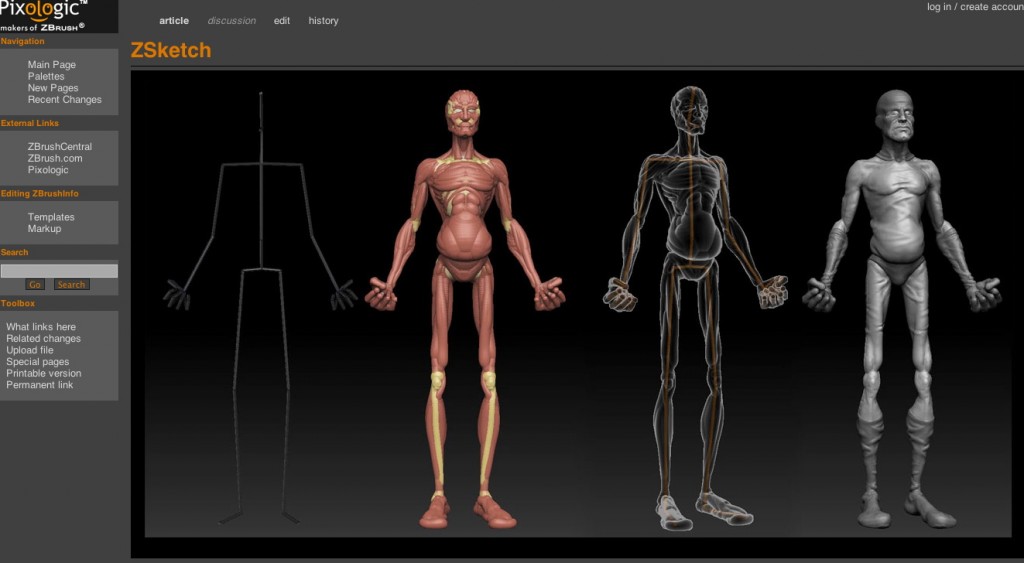
I must say that I do love the immediacy of the medium. I love being able to quickly squeeze and pinch or pull a shape out of a blob. This was probably my most frustrating aspect of digital sculpting, but is quickly changing. I hated having to be bound by the geometry under a piece, it still pisses me off from time to time. Zbrush’s zsketch is more in tuned to my traditional process though I am still butting up against geometry every now and then. I would say the same with being able to pose or move a piece. For me, doing this digitally (Zbrush, Mudbox) is time consuming and leaves me fumbling. I want to play with the form before finalizing it, and I do not feel as comfortable digitally with that as I would like. Some say the geometry is the armature. To me, that is a poor analogy, it is more like grit that is caught in my traditional clay and totally irritating me as I try to dance my hand over it.
This is an interview of 10 questions by Mathias Herbster of FH Vorarlberg University in Austria directed to Sculptor Bridgette Mongeon about the comparison of digital and traditional sculpture.
_____________________________________________________________________________

Sculptor, Writer and Speaker
Bridgette Mongeon is a sculptor, writer, illustrator and educator as well as a public speaker.
Her blog can be found at https://creativesculpture.com.
She is also the owner and creator of the God’s Word Collectible Sculpture series
Follow the artists on twitter twitter.com/Sculptorwriter twitter.com/creategodsword
Facebook http://www.facebook.com/bridgette.mongeon
Listen to The Creative Christian Podcast or the Inspiration/Generation Podcast Click on Podcast Host Bios for a list of all podcasts.
Listen to the Art and Technology Podcast
Creating An Author’s Page At Amazon For The Mudbox Book
For those of you who don’t know, I coauthored a book with my husband called Digital Sculpting in Mudbox: Essential Tools and Techniques. Most software books can become dated, but this book talks about things that others do not. Let me tell you about the two chapters that I am proud of. I should be proud, I wrote them and labored over them. One chapter brings a person through the entire process of sculpting a portrait digitally. Yes, I have taken my traditional process and expressed it digitally. So this book will help with that. You can use it if you are using Mudbox or the competition Zbrush. It will also help if you are a traditional sculptor. The other chapter talks about digital printing, milling and scanning. This is huge and I would love to do an entire book on this subject, just in case there should be a publisher that is interested. For those of you who don’t know, you can now print things in 3d. Yes, you can create objects in the computer and print them. Kind of like the Star trek replicator. The difficulty is, that not many artist know the processes that are available for this sort of thing. That is what this chapter is about. Breaking it down into bite sized pieces and also offering the reader a list of resources. In my opinion, this information is worth purchasing the book. You just can’t find it compiled anywhere else.
If you want to see my authors page just click on this Amazon link to the book and then on my name.
We have also put together a website and forums for this book. It is located at digitalsculpting.net Be sure to also check out the podcasts on art and technology at the website.
First Review on Our Mudbox Book
Renderosity wrote a review on the book that we wrote that just came out Digital Sculpting with Mudbox Essential Tools and Techniques for Artists. Check it out.
I Have Been Working On a Portrait of Mom
Many of you who read my blog https://creativesculpture.com/blog know that I have been transitioning from just traditional sculpture to digital. This is a portrait that I have been working on of my mother. It is created in Mudbox and still has a long way to go. But I thought I would post it. Mom passed away last August and so it was, at first, difficult to work on. I am, however, now very excited that I have started on it. I’m also glad I took the time, on one of my last visits, to gather lots of reference material. The new Mudbox has this cool feature called turntable. Even though mom is far from being done I though I would add it here.

More Quick Sketches In 3D
In a previous post “Thinking about fast. Is it the new slow” I had depicted some of my quick sketches in Mudbox. I have decided to try and do these regularly so I am going to insert some more. I may also switch to zbrush quick sketches. The timer is set for 30 minutes. If you want to share your quick sketches in Mudbox or zbrush I have created a challenge on the digitalsculpting.net website forum. Can’t wait to see what others have.
New Artwork- Working On A Cameo
Creating a bas-relief, a portrait that is flat and appears to have dimension, is something that I am asked to do quite often but have not had the chance to create. In the past, with the busy commission schedule in the studio I rarely have time to play in something or experiment. It is something that I have enjoyed about my graduate studies, exploration with play, and I love documenting my work! Working with a bas-relief created digitally was a way to explore this new style of sculpting.
The inspiration behind this new direction is the many cameos that my mother has given to me over the years. Beautiful women are sculpted in a variety of materials. Of course sculpting that small, the size of a brooch is a bit tedious and hard on the eyes. Besides I didn’t just want to make any person, I wanted to do a specific person.I was wondering if I could create this type of art using tra-digi means( traditional and digital process). Here are some photographs of my first attempts. I’m going to try some others and then have them printed or milled out as jewelry.
Mud.. What?

What is Mudbox? It is a digital sculpting tool. Just in case you have not deducted that from my previous posts. Yes it is like sculpting in real physical form, but… it is in my computer.
here is a photograph of what the program looks like. You can see the sculpting tools on the bottom and you can work in layers as well. There are also textures that can be used. I wish I could write more, but for now I hope this suffices. I’m on a deadline for writing this Mudbox book and need to get back to my chapters.
Check out the gallery on the Mudbox forum to see some spectacular work created in Mudbox.
Check out Bridgette’s book Digital Sculpting with Mudbox



